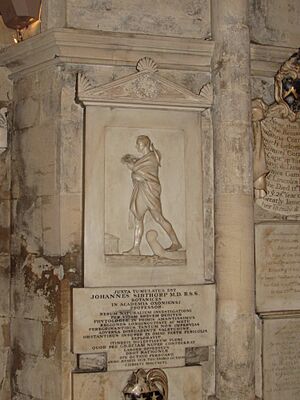John Sibthorp facts for kids
Quick facts for kids
John Sibthorp
|
|
|---|---|

Sibthorp in a doctoral robe
|
|
| Born | 28 October 1758 |
| Died | 8 February 1796 (aged 37) |
| Nationality | English |
| Alma mater | University of Oxford University of Edinburgh University of Montpellier |
| Parent(s) | Humphry Sibthorp |
| Scientific career | |
| Fields | |
| Author abbrev. (botany) | Sibth. |
John Sibthorp (born October 28, 1758 – died February 8, 1796) was an English botanist. A botanist is a scientist who studies plants. He is best known for his work on plants from Greece.
Contents
Early Life and Education
John Sibthorp was born in Oxford, England. His father, Humphry Sibthorp, was also a famous botanist. John followed in his father's footsteps.
He went to the University of Oxford and finished his studies in 1777. After that, he studied medicine at the University of Edinburgh in Scotland. He also studied at the University of Montpellier in France.
A Career in Botany
In 1784, John Sibthorp took over his father's important job. He became the Sherardian Professor of Botany at the University of Oxford. This was a special position for teaching and researching plants.
Instead of staying in Oxford, he decided to travel. He wanted to find new plants. He visited places like Göttingen and Vienna to prepare for his big trips.
Exploring Greece and Cyprus
John Sibthorp went on a botanical tour to Greece in 1786. He also visited Cyprus in 1787. On these trips, he collected many different plant species. He made detailed drawings and notes about them.
When he returned to England, he helped start the Linnean Society of London in 1788. This society was for scientists who studied nature. He also started working on a book about the plants of Oxfordshire. This book was called Flora Oxoniensis and was published in 1794.
Second Journey and Legacy
Sibthorp went on a second journey to Greece. Sadly, on his way home, he became very ill. He had a lung disease called consumption, which is now known as tuberculosis. He passed away in Bath, Somerset on February 8, 1796. He was buried at Bath Abbey.
In his will, John Sibthorp left his books about nature to the University of Oxford. He also created a special fund. This fund was to help publish his most important work, Flora Graeca. This huge book was about all the plants he found in Greece.

He had collected about three thousand plant species for this book. But he had not finished writing it. Other botanists, like Sir J.E. Smith, helped complete the Flora Graeca. It was a massive project, with many volumes and beautiful color drawings of the plants.
The standard short name for John Sibthorp in botany is Sibth.. This is used when scientists talk about plants he first described.
Sibthorpian Professorship
John Sibthorp's legacy also lives on through a special teaching position. The Sibthorpian Professorship of Plant Science at the University of Oxford is named after him. This professor continues to study plants, just like John Sibthorp did.
Images for kids



